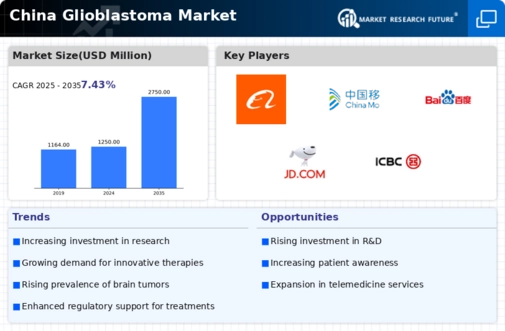Increased Research Funding
The allocation of increased research funding for glioblastoma treatment is a notable driver for the glioblastoma market in China. Government and private sector investments are focusing on innovative therapies, including gene therapy and novel drug formulations. Reports suggest that funding for cancer Market Research Future has seen a substantial rise, with an estimated increase of 15% annually. This financial support is likely to accelerate the development of new treatment modalities, which could significantly alter the treatment landscape for glioblastoma. Additionally, collaborations between academic institutions and pharmaceutical companies are becoming more prevalent, fostering an environment conducive to innovation. As a result, the glioblastoma market is poised for growth, driven by the influx of new therapies and clinical trials aimed at improving patient outcomes.
Growing Awareness and Education
The growing awareness and education regarding glioblastoma among healthcare professionals and the general public are pivotal for the glioblastoma market in China. Increased educational initiatives and campaigns are helping to disseminate information about the disease, its symptoms, and treatment options. This heightened awareness is likely to lead to earlier diagnosis and treatment, which can improve survival rates. Furthermore, as more patients become informed about glioblastoma, there may be a greater demand for advanced treatment options, including clinical trials and novel therapies. The Chinese healthcare system is increasingly prioritizing patient education, which could further enhance the market dynamics. Consequently, this trend may contribute to a more informed patient population, ultimately driving growth in the glioblastoma market.
Rising Incidence of Glioblastoma
The increasing incidence of glioblastoma in China is a critical driver for the glioblastoma market. Recent statistics indicate that the age-standardized incidence rate of glioblastoma in China is approximately 3.2 per 100,000 individuals. This rising trend is likely attributed to factors such as an aging population and environmental influences. As the number of diagnosed cases escalates, the demand for effective treatment options intensifies, thereby propelling the growth of the glioblastoma market. Furthermore, the healthcare system's focus on improving diagnostic capabilities may lead to earlier detection, which could further increase the number of reported cases. Consequently, pharmaceutical companies are likely to invest more in research and development to address this growing need, thereby enhancing the overall market landscape.
Advancements in Diagnostic Technologies
Technological advancements in diagnostic tools are significantly impacting the glioblastoma market in China. Innovations such as advanced imaging techniques and molecular diagnostics are enabling earlier and more accurate detection of glioblastoma. For instance, the integration of MRI and PET scans has improved the precision of tumor localization and characterization. This progress not only aids in timely treatment initiation but also enhances patient outcomes. As diagnostic capabilities improve, the market is expected to witness a surge in demand for targeted therapies and personalized treatment plans. The Chinese government is also investing in healthcare infrastructure, which may further facilitate the adoption of these advanced diagnostic technologies. This trend indicates a promising future for the glioblastoma market, as better diagnostics lead to more effective treatment strategies.
Regulatory Support for Innovative Therapies
Regulatory support for innovative therapies is emerging as a significant driver for the glioblastoma market in China. The Chinese government has been actively streamlining the approval process for new cancer treatments, which may facilitate quicker access to novel therapies for patients. Recent initiatives have aimed to reduce the time required for clinical trial approvals and enhance the overall regulatory framework. This supportive environment is likely to encourage pharmaceutical companies to invest in research and development for glioblastoma treatments. As a result, the market may witness an influx of innovative therapies that could improve patient outcomes. Moreover, the collaboration between regulatory bodies and industry stakeholders is expected to foster a more dynamic glioblastoma market, ultimately benefiting patients and healthcare providers alike.

















Leave a Comment